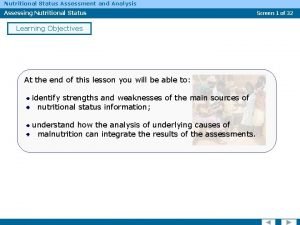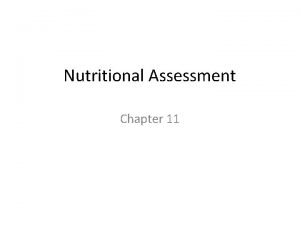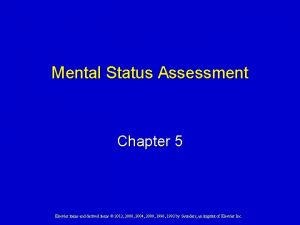The assessment of oral status and oral health


- Slides: 2


The assessment of oral status and oral health related quality of life among the elderly ~ Comparing physical checkup group and clinical dental group in Taipei n The aging of the population has been a global trend, with no exception of Taiwan. Oral health status is an important factor affecting health and well-being of the elderly. With the increasing of the age of the elderly, their physical function is gradually declining, causing difficulty in speaking, chewing and swallowing and also indirectly affecting the general health. The purpose of the present study was to investigate the oral health status of the elderly in Taipei region and to confer the factor affecting oral health-related quality of life (OHRQOL) of the elderly. A cross-sectional study technique and a convenient sampling method was used in the present study. A total of 409 elderly, individuals who were over 65 years old and were easy to communicate with, were include in this study. The data regarding the questionnaire, which was collected by face-to-face interview, and the clinical oral examination gathered by the dentists. The assessment tools were (1)Dental clinic charts, (2)Geriatric Oral Health Assessment Index (GOHAI), (3)Face scale, and (4)Basic questionnaire. The average was 73. 77? b 7. 34 years old and the major of the survey subjects were between 65 to 74 years old (55. 8 %). With the respect of GOHAI, the average score in the elderly from physical checkup group was 52. 35± 4. 56 while the elderly from clinical dental group was 46. 7± 7. 71, which showed better OHRQOL in the elderly from physical checkup group. With the respect of Face Scale, subjects with high quality of life (82. 7% were from physical checkup group and 74. 2% were from clinical dental group), which showed better QOL in the elderly from physical checkup group. With respect to dentition status, the average residual teeth were 21. 36± 8. 17 in the elderly from physical checkup group while the other was 19. 37± 9. 53. The A type in the Eichner Index classification was 60. 6% of the elderly from physical checkup group and in 53. 5% the other. The 4. 3% of the elderly from physical checkup group was edentulism while the 6. 5% of the elderly from clinical dental group was edentulism. The result showed that the elderly from physical checkup group had better oral health status. The major factor affecting OHRQOL in the elderly was chewing ability, no matter measured in subjective or objective way, while other minor factors included the age, marital status, chronic systemic disease, medication, daily oral hygiene activity and whether the subject wore denture or not. This survey subjects lived almost in Taipei region. We hope, however, we can expand the sampling data to the whole country, and investigate the oral health problems in the elderly in the future, as the reference to promote the elderly oral health.



